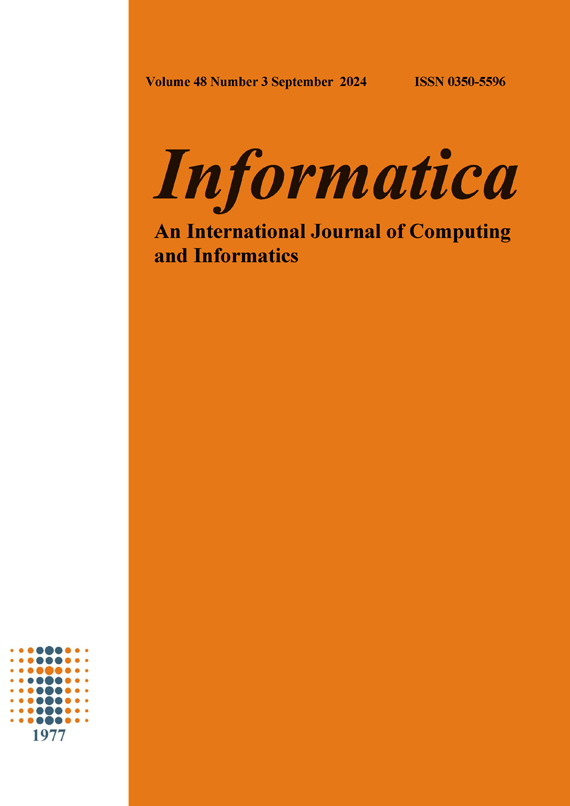Cloud Computing Security: Assured Deletion
DOI:
https://doi.org/10.31449/inf.v48i3.6245Abstract
ABSTRACT: With the advent of cloud computing, many organizations, institutions, and individuals have chosen to store their data in the cloud as a way to compensate for limited local storage capabilities and reduce expenses. However, the process of uploading data to the cloud results in relinquishing control over it, leaving the data owner unaware of the details of its storage and location. Hence, ensuring data confidentiality and integrity has emerged as a critical concern, especially with regard to cloud employees and other potential attacks. A significant amount of investigation has been conducted on the security aspects of cloud computing, with a particular focus on permanent removals. Hence, our research proposes a security system that addresses cloud-related concerns by using two distinct cloud platforms, cryptographic key partitioning, cryptographic-based random writing, and link deletion in cases of confirmed deletion. Experimental resultsReferences
S. Kaushik and C. Gandhi, “Capability Based Outsourced Data Access Control with Assured File Deletion and Efficient Revocation with Trust Factor in Cloud Computing,” International Journal of Cloud Applications and Computing, vol. 10, no. 1, pp. 64–84, 2020, doi: 10.4018/IJCAC.2020010105.
A. Lec Ghassan Sabeeh Mahmood, “Data Security Protection in Cloud Computing by using Encryption ,” 2017. [Online]. Available: www.kujss.com
A. Hameed and Ogr. Uye. O. Karan, “Cloud Data Storage Confidentiality Using Steganography and Visual Cryptography: A Review,” Journal of Education and Science, vol. 32, no. 4, pp. 60–70, Dec. 2023, doi: 10.33899/edusj.2023.140697.1370.
H. Kumar, P. J. Soh, and M. A. Ismail, “Big Data Streaming Platforms: A Review,” Iraqi Journal for Computer Science and Mathematics, pp. 95–100, Apr. 2022, doi: 10.52866/ijcsm.2022.02.01.010.
B. Li, Y. Fu, and K. Wang, “A Review on Cloud Data Assured Deletion,” in 2022 Global Conference on Robotics, Artificial Intelligence and Information Technology (GCRAIT), IEEE, Jul. 2022, pp. 451–457. doi: 10.1109/GCRAIT55928.2022.00101.
J. Tian and Z. Wang, “Cloud data assured deletion scheme based on dynamic sliding window,” Peer Peer Netw Appl, vol. 15, no. 4, pp. 1817–1833, Jul. 2022, doi: 10.1007/s12083-022-01318-3.
Y. Miao et al., “Privacy-Preserving Attribute-Based Keyword Search in Shared Multi-owner Setting,” IEEE Trans Dependable Secure Comput, vol. 18, no. 3, pp. 1080–1094, May 2021, doi: 10.1109/TDSC.2019.2897675.
J. Tian and T. Zhang, “Secure and effective assured deletion scheme with orderly overwriting for cloud data,” Journal of Supercomputing, vol. 78, no. 7, pp. 9326–9354, May 2022, doi: 10.1007/s11227-021-04297-z.
J. Ma, M. Wang, J. Xiong, and Y. Hu, “CP-ABE-based secure and verifiable data deletion in cloud,” Security and Communication Networks, vol. 2021, 2021, doi: 10.1155/2021/8855341.
H. Ritzdorf, N. Karapanos, and S. Čapkun, “Assited deletion of releted content,” in ACM International Conference Proceeding Series, Association for Computing Machinery, Dec. 2014, pp. 206–215. doi: 10.1145/2664243.2664287.
K. Q. Aziz and B. A. Mahmood, “Assured data deletion in cloud computing: security analysis and requirements,” Indonesian Journal of Electrical Engineering and Computer Science, vol. 28, no. 2, pp. 1174–1183, Nov. 2022, doi: 10.11591/ijeecs. v28.i2.pp1174-1183.
J. Hao, J. Liu, W. Wu, F. Tang, and M. Xian, “Secure and Fine-Grained Self-Controlled Outsourced Data Deletion in Cloud-Based IoT,” IEEE Internet Things J, vol. 7, no. 2, pp. 1140–1153, Feb. 2020, doi: 10.1109/JIOT.2019.2953082.
S. M. Khudaier and B. A. Mahmood, “A Review of Assured Data Deletion Security Techniques in Cloud Storage,” Iraqi Journal of Science, vol. 64, no. 5, pp. 2492–2511, 2023, doi: 10.24996/ijs.2023.64.5.33.
Y. Tang, P. P. C. Lee, J. C. S. Lui, and R. Perlman, “FADE: Secure Overlay Cloud Storage with File Assured Deletion.”
Y. Luo, M. Xu, S. Fu, and D. Wang, “Enabling assured deletion in the cloud storage by overwriting,” in SCC 2016 - Proceedings of the 4th ACM International Workshop on Security in Cloud Computing, Co-located with Asia CCS 2016, Association for Computing Machinery, Inc, May 2016, pp. 17–23. doi: 10.1145/2898445.2898447.
Z. Igarramen and M. Hedabou, “FADETPM: Novel Approach of File Assured Deletion Based on Trusted Platform Module,” 2019, pp. 49–59. doi: 10.1007/978-3-319-97719-5_4.
Z. Xie, W. Fu, J. Xu, and T. Zhu, “Assured Deletion: A Scheme Based on Strong Nonseparability,” J Sens, vol. 2022, 2022, doi: 10.1155/2022/9691724.
G. Wang and Y. Luo, “A Review on Assured Deletion of Cloud Data Based on Cryptography,” Procedia Comput Sci, vol. 187, pp. 580–585, 2021, doi: 10.1016/j.procs.2021.04.111.
S. B. Joshi and S. D. Panchal, “A Survey on Assured Data Deletion in Cloud Storage,” International Journal of Computer Sciences and Engineering, vol. 7, no. 6, pp. 548–553, Jun. 2019, doi: 10.26438
Downloads
Published
Issue
Section
License
I assign to Informatica, An International Journal of Computing and Informatics ("Journal") the copyright in the manuscript identified above and any additional material (figures, tables, illustrations, software or other information intended for publication) submitted as part of or as a supplement to the manuscript ("Paper") in all forms and media throughout the world, in all languages, for the full term of copyright, effective when and if the article is accepted for publication. This transfer includes the right to reproduce and/or to distribute the Paper to other journals or digital libraries in electronic and online forms and systems.
I understand that I retain the rights to use the pre-prints, off-prints, accepted manuscript and published journal Paper for personal use, scholarly purposes and internal institutional use.
In certain cases, I can ask for retaining the publishing rights of the Paper. The Journal can permit or deny the request for publishing rights, to which I fully agree.
I declare that the submitted Paper is original, has been written by the stated authors and has not been published elsewhere nor is currently being considered for publication by any other journal and will not be submitted for such review while under review by this Journal. The Paper contains no material that violates proprietary rights of any other person or entity. I have obtained written permission from copyright owners for any excerpts from copyrighted works that are included and have credited the sources in my article. I have informed the co-author(s) of the terms of this publishing agreement.
Copyright © Slovenian Society Informatika








